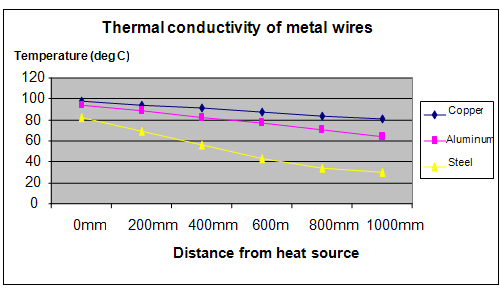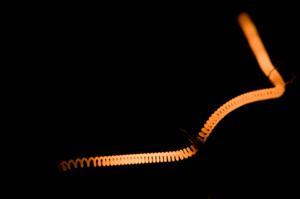| Complexity level: | 7 |
| Project cost ($): | 30 |
| Time required: | 1 hour to prepare, 1 hour for the science project experiment |
| Material availability: | Easily found at a hobby store |
| Safety concerns: | Handle boiling water very carefully – adult assistance is required. |
Hypothesis
Copper wire is a better thermal conductor than steel or aluminum, and steel wire is the worst.
Overview
Thermal conductivity
Thermal conductivity refers to the ability of a material to conduct heat. The unit measurement for thermal conductivity is watts per meter Kelvin. Thermal resistivity, which refers to the opposition to thermal conduction, is the reciprocal of thermal conductivity.
The transfer of thermal energy from a warmer area to a cooler area is called thermal conduction. The rate at which thermal energy is being transferred is called thermal conductivity. Thermal energy is always transferred from a warmer to a cooler area. Thermal conduction can also occur between 2 different objects that touch each other.
All matter is made from particles of atoms or molecules. When heat is applied to one area of an object, the molecules within that area will receive thermal energy and start to vibrate more quickly. As they vibrate, the particles collide more often with neighboring particles and transfer over some of their energy. When this happens, the thermal energy of the original particle is reduced while the neighboring particle will gain thermal energy. This process continue until a state of equilibrium is reached between all neighboring particles.
Scientific Terms
Materials
The materials required for this science fair project:
- Copper wire 1.1 meter in length
- Aluminum wire 1.1 meter in length
- Steel wire 1.1 meter in length
(All 3 types of wire must have the same diameter)
- 2 beakers
- tap water
- 1 hot plate
- 1 meter long ruler
- 1 black marker pen
- 1 infrared digital thermometer
- A clock
Procedure
1. For this science fair project, the independent variable is the type of wire used – copper, aluminum and steel. The dependent variable is the thermal conductivity of the wires. This is determined by using the digital infrared thermometer to measure the temperature of the wires. The constants (control variables) are the length and diameter of the wires, the temperature of the water and the distance between the measurements.
2. The tips of all 3 wires are bent at 90 degree angle, 50mm from their tips so that the center portion will be 1 meter long. Using the marker pen, a mark is placed every 200mm along the wire, starting from the first bent corner to the last one. There should be 6 markings on each wire.
3. One of the beakers is filled with tap water and brought to a boil on the hot plate. The second beaker will remain empty. The bent corners of the wires are suspended on the edge of the 2 beakers. One end of the bent wire will be immersed into the boiling water.
4. After 20 minutes, the temperature is measured using the digital infrared thermometer at the spots that were marked on the wire earlier. All measured temperature values for the copper, aluminum and steel wires are recorded in the table given below.

Results
It was observed that the temperature of the copper wire increased along the length of the wire, more quickly than the others.
|
Wire type |
Temperature along the wire at distance from heat source (°C) |
|||||
|
0mm |
200mm |
400mm |
600m |
800mm |
1000mm |
|
|
Copper |
98.0 |
94.5 |
91.0 |
87.5 |
84.0 |
80.5 |
|
Aluminum |
94.5 |
88.5 |
82.5 |
76.5 |
70.5 |
64.5 |
|
Steel |
82.5 |
69.5 |
56.5 |
43.5 |
33.5 |
29.5 |
The graph below represents the results of our science fair project:

Conclusion
The hypothesis that copper wire is the best thermal conductor and steel wire is the worst among the 3 types of wire, is proven to be true.
The concept of thermal conductivity can be applied to produce better cookware for cooking food and boiling water. When a pot is placed on a stove, thermal energy is transferred from the fire to the metal pot and eventually to the food and water. Materials with poor thermal conductivity can be used as thermal insulators.
Also consider
Try to repeat the experiment using different metals like brass, nickel or zinc.
The experiment can also be repeated using different lengths and diameters of wire.
References
Thermal conductivity - http://en.wikipedia.org/wiki/Thermal_conductivity
Thermal conductivity of metals - http://www.engineeringtoolbox.com/thermal-conductivity-metals-d_858.html
What is thermal conduction? - http://www.wisegeek.com/what-is-thermal-conduction.htm

